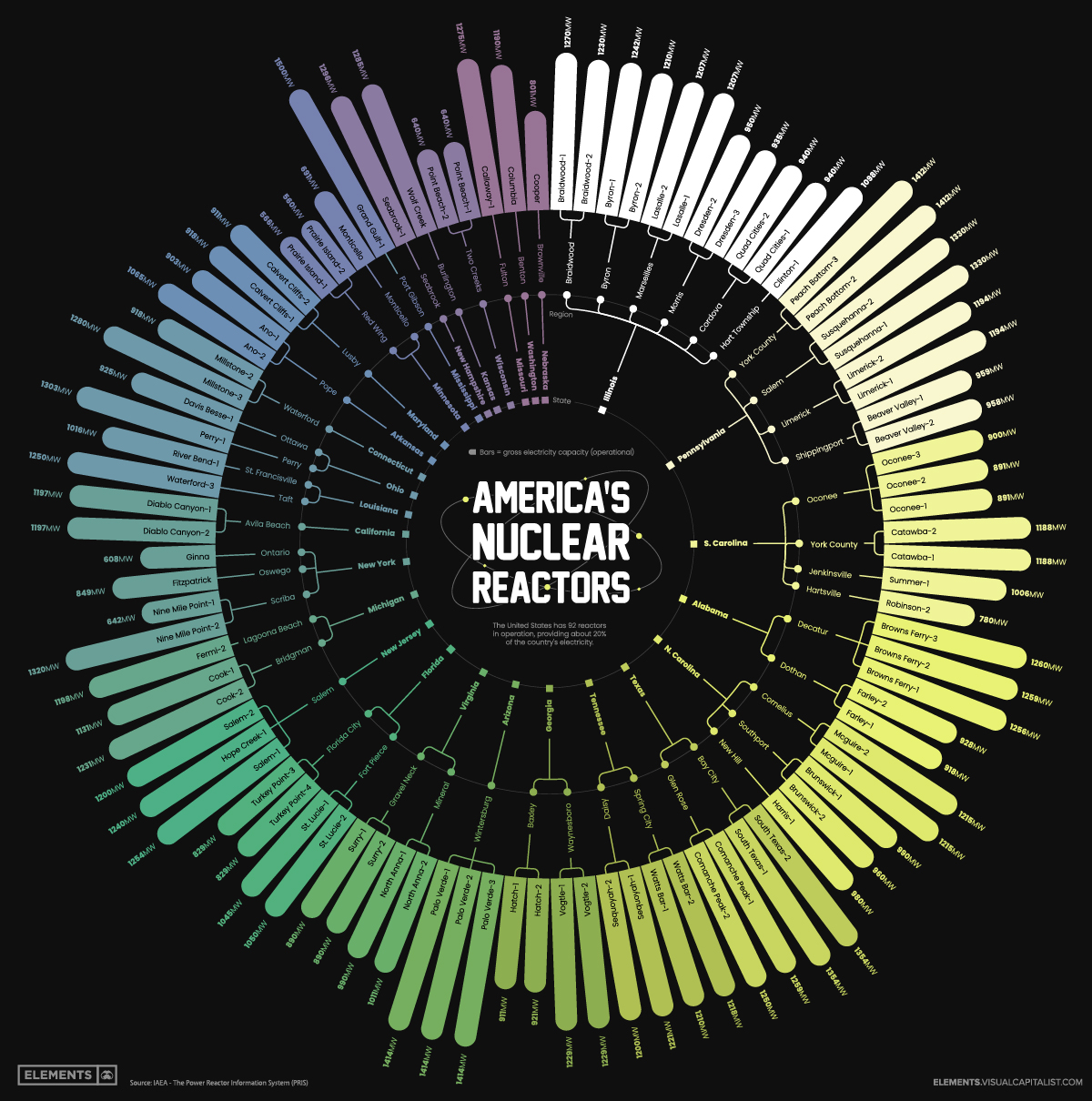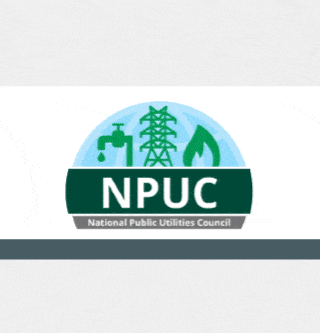Clean Energy
Mapped: Nuclear Reactors in the U.S.
View the full resolution version of this graphic.
Mapped: Nuclear Reactors in the U.S.
This was originally posted on June 8, 2022, on Elements.
The United States is the world’s largest producer of nuclear power, representing more than 30% of the world’s nuclear power generation.
America has 92 reactors in operation, providing about 20% of the country’s electricity.
The above infographic uses data from the International Atomic Energy Agency to showcase every single nuclear reactor in America.
Nuclear Development
Nuclear power in the U.S. dates back to the 1950s.
George Westinghouse produced the first commercial pressurized water reactor in 1957 in Shippingport, Pennsylvania. The technology is used in approximately half of the 450 nuclear power reactors worldwide.
Today, over 30 different power companies across 30 states operate nuclear facilities in the U.S., and most nuclear power reactors are located east of the Mississippi River.
Illinois has more reactors than any state, with 11 reactors and the largest total nuclear electricity generation capacity at about 11,582 megawatts (MW). Meanwhile, the largest reactor is at the Grand Gulf Nuclear Station in Port Gibson, Mississippi, with a capacity of about 1,500 MW.
Most American reactors in operation were built between 1967 and 1990. Until 2013 there had been no new constructions started since 1977, according to the World Nuclear Association.
Nuclear power reactors in America receive 40-year operating licenses from the U.S. Nuclear Regulatory Commission (NRC), with companies able to apply for 20-year extensions. The oldest operating reactor, Nine Mile Point Unit 1 in New York, began commercial operation in December 1969. The newest reactor to enter service, Watts Bar Unit 2, came online in 2016.
The Future of Nuclear Power in the U.S.
U.S. nuclear power’s capacity peaked in 2012 at about 102,000 MW, with 104 operating nuclear reactors operating.
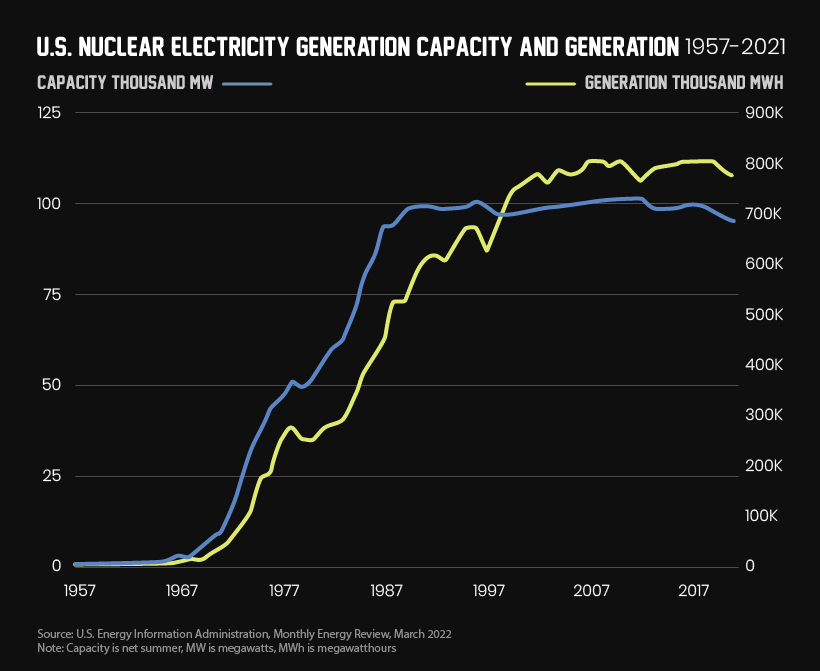
Since nuclear plants generate nearly 20% of U.S. electricity and about half of the country’s carbon‐free electricity, the recent push from the Biden administration to reduce fossil fuels and increase clean energy will require significant new nuclear capacity.
Today, there are two new reactors under construction (Vogtle 3 and 4) in Georgia, expected to come online before 2023.
Furthermore, some of the Inflation Reduction Act provisions include incentives for the nuclear industry. Starting in 2024, for example, utilities will be able to get a credit of $15 per megawatt-hour for electricity produced by existing nuclear plants. Nuclear infrastructure projects could also be eligible for up to $250 billion worth of loans to update, repurpose, and revitalize energy infrastructure that has stopped working.
Clean Energy
Visualized: The Four Benefits of Small Modular Reactors
What advantages do small modular reactors offer compared to their traditional counterparts?
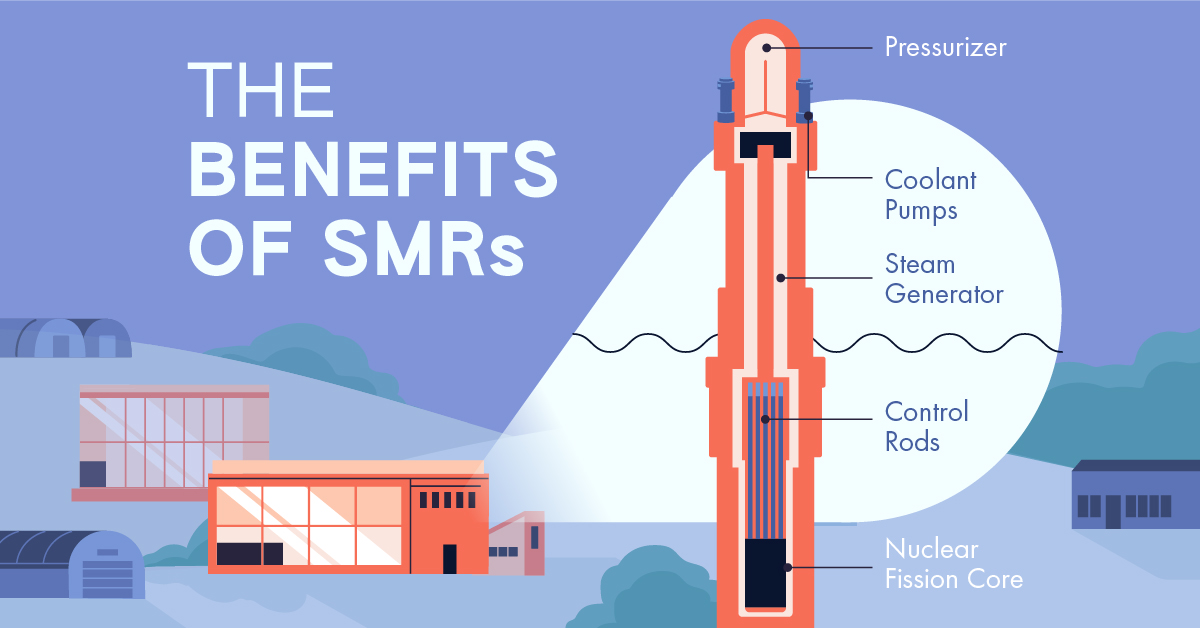
Visualized: The Four Benefits of Small Modular Reactors
Nuclear power has a crucial role to play on the path to net zero. Traditional nuclear plants, however, can be costly, resource-intensive, and take up to 12 years to come online.
Small modular reactors (SMR) offer a possible solution.
Created in partnership with the National Public Utilities Council, this infographic explores some of the benefits SMRs can offer their traditional counterparts. Let’s dive in.
The Four Key Benefits of SMRs, Explained
An SMR is a compact nuclear reactor that is typically less than 300 megawatts electric (MWe) in capacity and manufactured in modular units.
Here are some of the benefits they offer.
#1: Lower Costs
SMRs require a lower upfront capital investment due to their compact size.
SMRs can also match the per-unit electricity costs of traditional reactors due to various economic efficiencies related to their modular design, including design simplification, factory fabrication, and potential for regulatory harmonization.
#2: Quicker Deployment
Traditional nuclear plants can take up to 12 years to become operational. This is primarily due to their site-specific designs and substantial on-site labor involved in construction.
SMRs, on the other hand, are largely manufactured in factories and are location-independent, which minimizes on-site labor and expedites deployment timelines to as little as three years. This means they can be deployed relatively quickly to provide emissions-free electricity to the grid, supporting growing electricity needs.
#3: Siting Flexibility and Land Efficiency
SMRs have greater siting flexibility compared to traditional reactors due to their smaller size and modular design. In addition, they can utilize land more effectively than traditional reactors, yielding a higher output of electrical energy per unit of land area.
| Rolls-Royce SMR, UK (Proposed) | Median-Sized U.S. Nuclear Plant | |
|---|---|---|
| Capacity | 470 MW | 1,000 MW |
| Area Requirement | 10 Acres* | 832 Acres |
| Land/Space Efficiency | 47 MW/Acre | 1.2 MW/Acre |
*Estimated area requirement
Given their flexibility, SMRs are also suitable for installation on decommissioned coal power plant sites, which can support the transition to clean electricity while utilizing existing transmission infrastructure.
#4: Safety
SMRs have simpler designs, use passive cooling systems, and require lower power and operating pressure, making them inherently safer to operate than traditional reactors.
They also have different refueling needs compared to traditional plants, needing refueling every 3–7 years instead of the 1–2 years typical for large plants. This minimizes the transportation and handling of nuclear fuel, mitigating the risk of accidents.
The Road Ahead
As of early 2024, only five SMRs are operating worldwide. But with several other projects under construction and nearly 20 more in advanced stages of development, SMRs hold promise for expanding global emission-free electricity capacity.
With that said, certain obstacles remain for the wide-scale adoption of SMRs in the United States, which was particularly apparent in the 2023 cancellation of the NuScale SMR project.
To fully realize the benefits of SMRs and advance decarbonization efforts, a focus on financial viability, market readiness, and broader utility and public support may be essential.
Learn how the National Public Utilities Council is working toward the future of sustainable electricity.
Clean Energy
The $3 Trillion Clean Energy Investment Gap, Visualized
In this graphic, we explore the $3 trillion clean energy investment gap visualized by sector, according to BloombergNEF data.
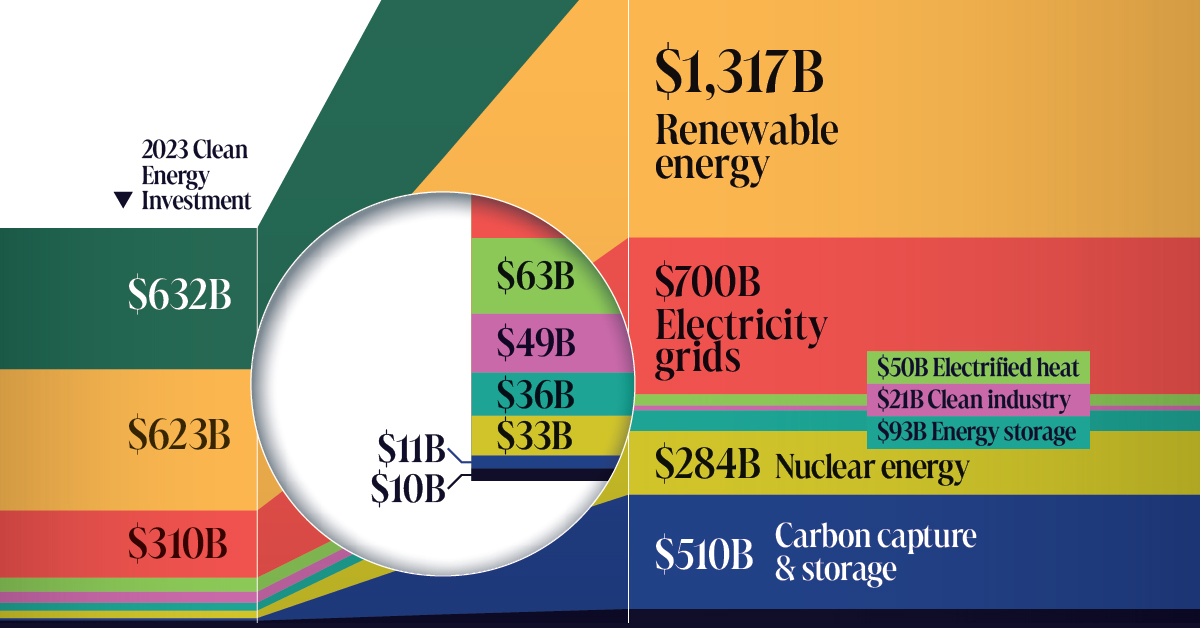
The $3 Trillion Clean Energy Investment Gap, Visualized
Global investment in the clean energy transition grew by 17% in 2023, showing resilience despite geopolitical tensions, high interest rates, and inflation.
But was it enough to keep the world on track to hit net zero by 2050?
To answer this question, we compare 2023 clean energy investment by sector with what’s annually needed to reach net zero by 2050, in partnership with the National Public Utilities Council.
The Investment Gap, By Sector
According to BloombergNEF data, annual global investment in the energy transition is at an all-time high. Despite this, only the electrified heat and clean industry sectors are meeting the thresholds necessary to hit net zero by 2050.
| 2023 Investment | Required Annual Investment for Net Zero*, 2024–2030 | Investment Gap | |
|---|---|---|---|
| Electrified transport | $632B | $1,805B | $1,173B |
| Renewable energy | $623B | $1,317B | $694B |
| Electricity grids | $310B | $700B | $390B |
| Electrified heat | $63B | $50B | -$13B |
| Clean industry | $49B | $21B | -$28B |
| Energy storage | $36B | $93B | $57B |
| Nuclear energy | $33B | $284B | $251B |
| Carbon capture and storage (CCS) | $11B | $510B | $499B |
| Hydrogen | $10B | $62B | $52B |
| TOTAL | $1,767B | $4,842B | $3,075B |
*BloombergNEF’s Net-Zero 2050 Scenario
To stay on track for net zero by 2050, the yearly investments in electrified transport, renewable energy, power grids, and energy storage must more than double their current rates for the rest of the decade.
Hydrogen, nuclear, and carbon capture and storage (CCS) have an even steeper hill to climb and must grow 6, 9, and 46 fold, respectively.
The Path Forward
It’s important to note that despite the current annual investment gap of $3T, the clean energy industry continues to exhibit positive trends.
Investment in electrified transport, for instance, surpassed that in renewable energy for the first time in 2023, marking a win for the sector.
Emerging sectors also experienced robust expansion despite being furthest off-target. Investments in hydrogen tripled to $10B, CCS nearly doubled to $11B, and energy storage witnessed a 76% increase to reach $36B in 2023.
These encouraging developments underscore the industry’s potential to drive transformative change and pave the way for a more sustainable and resilient energy landscape in the years ahead.
Learn how the National Public Utilities Council is working toward the future of sustainable electricity.
-
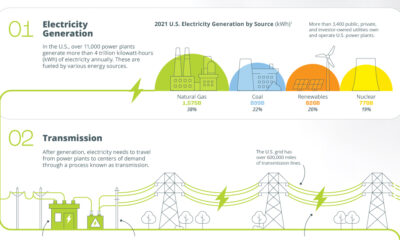
 Electrification1 year ago
Electrification1 year agoVisualized: How the Power Grid Works
-
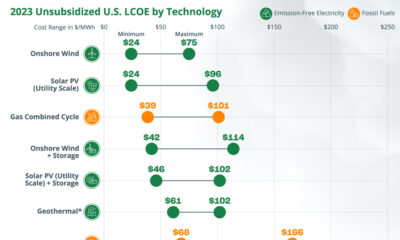
 Energy Shift9 months ago
Energy Shift9 months agoRanked: The Cheapest Sources of Electricity in the U.S.
-
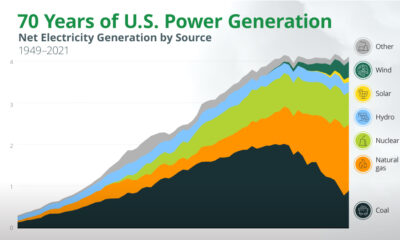
 Energy Shift1 year ago
Energy Shift1 year agoAnimated: 70 Years of U.S. Electricity Generation by Source
-
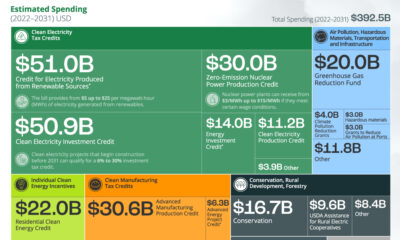
 Clean Energy1 year ago
Clean Energy1 year agoBreaking Down Clean Energy Funding in the Inflation Reduction Act
-
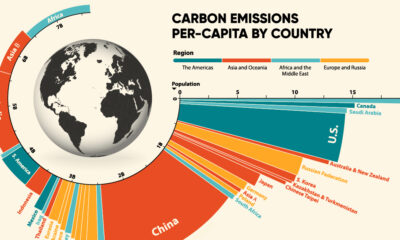
 Emissions1 year ago
Emissions1 year agoVisualizing Global Per Capita CO2 Emissions
-
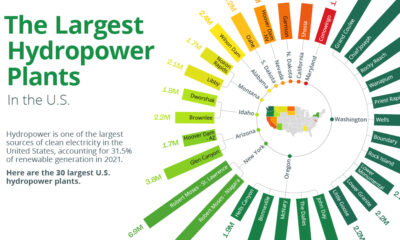
 Clean Energy1 year ago
Clean Energy1 year agoThe 30 Largest U.S. Hydropower Plants
-
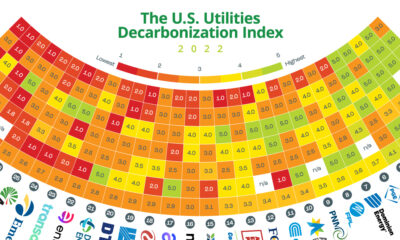
 Decarbonization1 year ago
Decarbonization1 year agoThe U.S. Utilities Decarbonization Index
-
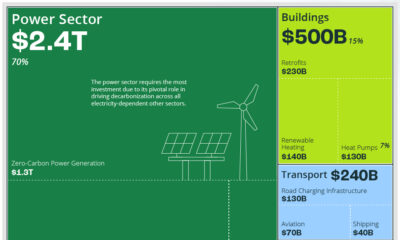
 Clean Energy6 months ago
Clean Energy6 months agoBreaking Down the $110 Trillion Cost of the Clean Energy Transition

